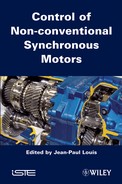Table of Contents
Chapter 1: Self-controlled Synchronous Motor: Principles of Function and Simplified Control Model
1.2. Design aspects specific to the self-controlled synchronous machine
1.3. Simplified model for the study of steady state operation
1.4. Study of steady-state operation
1.5. Operation at nominal speed, voltage and current
1.6. Operation with a torque smaller than the nominal torque
1.7. Operation with a speed below the nominal speed
1.9. Equivalence of a machine with a commutator and brushes
1.10. Equations inferred from the theory of circuits with sliding contacts
1.11. Evaluation of alternating currents circulating in steady state in the damper windings
1.12. Transposition of the study to the case of a negative rotational speed
1.13. Variant of the base assembly
1.15. List of the main symbols used
2.2. Choice of the expression of Nk
2.4. General properties of coefficients <X>, <Y> and <Z>
2.5. Electrical dynamic equations
2.6. Expression of electromechanical variables
2.8. Writing of equations in terms of coenergy
2.11. Appendix 1: value of coefficients <X>, <Y> and <Z>
2.12. Appendix 2: derivatives of coefficients <X>, <Y> and <Z>
2.13. Appendix 3: simplifications for small μ
2.14. Appendix 4 – List of the main symbols used in Chapters 1 and 2
Chapter 3: Synchronous Machines in Degraded Mode
3.2. Analysis of the main causes of failure
3.3. Reliability of a permanent magnet synchronous motors drive
3.5. Optimal supplies of permanent magnet synchronous machines in the presence of faults
3.6. Supplies of faulty synchronous machines with non-sinusoidal back electromagnetic force
3.7. Experimental learning strategy in closed loop to obtain optimal currents in all cases
Chapter 4: Control of the Double-star Synchronous Machine Supplied by PWM Inverters
4.2. Description of the electrical actuator
4.4. Dynamic models of the double-star synchronous machine
4.5. Control of the double-star synchronous machine
5.1. Introduction and presentation of the electrical machines
5.2. Control model of inverter-fed permanent magnet synchronous machines
5.3. Torque control of multiphase machines
5.4. Modeling and torque control of multiphase machines in degraded supply mode
Chapter 6: Hybrid Excitation Synchronous Machines
6.2. Modeling with the aim of control
6.3. Control by model inversion
6.4. Overspeed and flux weakening of synchronous machines
Chapter 7: Advanced Control of the Linear Synchronous Motor
7.2. Classical control of linear motors
7.3. Advanced control of linear motors
7.8. Appendix: LMD10-050 Datasheet of ETEL
Chapter 8: Variable Reluctance Machines: Modeling and Control
8.2. Synchronous reluctance machines
8.3. Switched reluctance machines
Chapter 9: Control of the Stepping Motor
9.5. Advanced control: the control of chaos
Chapter 10: Control of Piezoelectric Actuators
10.2. Causal model in the supplied voltage referential
10.3. Causal model in the referential of the traveling wave
10.4. Control based on a behavioral model
